evmc@qf.org.qa
+974 4454 0004
evmc@qf.org.qa
+974 4454 0004
The EVMC laboratory has two wings; Diagnosis and Research. The laboratory offers a vast range of testing panels to support EVMC clinicians and external veterinarians to efficiently diagnose a wide range of diseases affecting horses. The test portfolio of the diagnostic laboratory is constantly increasing and international accreditation for majority of these tests is under process.
With a team of several veterinarians and laboratory technicians specialized in pathology, clinical pathology, veterinary microbiology and molecular diagnostics the laboratory operates 24/7 under strict institutional biosafety and biosecurity regulations. Periodic quality controls and quality assessments are in place to ensure that EVMC diagnostic laboratory reports can be guaranteed.
For the type of test, required sample, sample handling, and turnaround time, please click on the desired service section.
For test days, turnaround time, prices and sampling instructions please click here.....
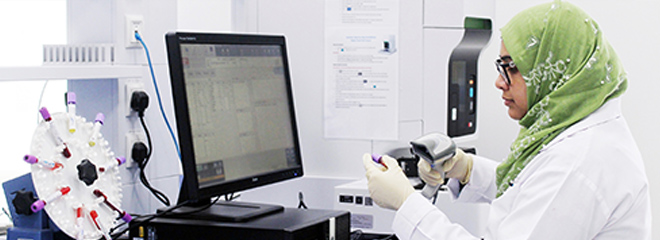
The hematology services include testing blood samples for any abnormalities on the cellular number, morphology, and reactivity of blood constituent cells. This section covers assessing clinical conditions that reflect alterations in the blood profile due to bacterial, fungal, viral, chlamydial, nutritional, allergic, and parasitic diseases in horses. This section also covers abnormalities of blood cells architecture, haemoglobin, coagulation factors and blood proteins, blood-forming organs, malignancies, and cancers. Hematology service offer CBC with differential, blood coagulation tests, and body fluid cell counts using leading market analysers.
| Test | Sample | Handling | TAT |
|---|---|---|---|
| CBC | Whole blood in EDTA Tube |
1hr - Room Temperature;
1hr - Refrigerated |
1hr |
| TP | Body fluid in EDTA Tube |
Room temperature | 30 mins |
| Coagulation Test PT, APTT |
Whole blood in Sodium Citrate Tube |
Refrigerated with ice packs |
1 hr |
| PCV | Whole blood in EDTA Tube |
Room temperature | 3 mins |
| BF Cell Count | Body fluid in EDTA Tube |
1hr - Room Temperature;
1hr - Refrigerated |
1 hr |
| Equine Activated Coag test iSTAT |
Arterial, venous, or capillary whole blood with no anticoagulant |
Not required | 30 mins |
| Fibrinogen | Whole blood in EDTA Tube |
Room temperature | 30 mins |
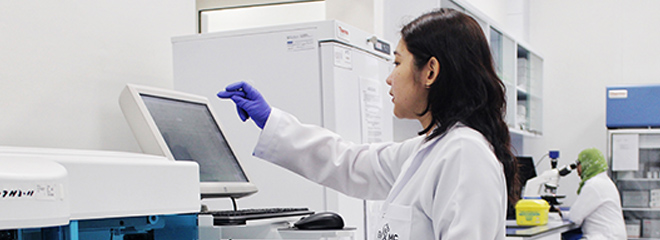
Vital organs such as the heart, liver, kidneys, and lungs communicate with each other through chemical regulators synthesised in the nucleus or in the cytoplasm of the cells in these organs. Analyses of these biochemical substances are crucial in assessing the cellular pathophysiological status of the organs in gastrointestinal, genitourinary, cardiovascular, respiratory, reproductive, and musculoskeletal systems and hence the health of these organs are assessed. Our laboratory offers common clinical chemistry test panels for horses. This includes, comprehensive profile: Glucose, Blood Urea Nitrogen (BUN), Creatinine, Total Protein, Albumin, Globulins, Phosphorus, Sodium, Chloride, Potassium, Total CO2, Anion gap, Total and Ionized Calcium, Total Bilirubin, Alkaline Phosphate, ALT, and GGT. Others are renal, liver and muscle profiles, inflammation assessment (Total protein, Albumin, Globulin, Amyloid A in serum), electrolytes balance assessment (Na, Cl, Mg, PO4, Ca, K) and equine weight loss profile (AP, GGT, Bile Acid, Albumin, TP, Total globulin, A/G ratio and CBC). Equine blood gas panel includes testing pH, pCO2, pO2, tHb, K+, Na+, cCa2+, Cl-, Glu, Lac, Crea, Urea, tBil in the whole blood. Cholesterol, Triglycerides HDL and LDL are also available on demand. Urinalysis is carried out using urine dipstick test, total protein and specific gravity are performed by refractometer along with direct microscopy, stained and unstained urine cytology and urine culture.
| Test | Sample | Handling | TAT |
|---|---|---|---|
| Comprehensive Panel | Plasma (Lithium Heparin Tube) or Serum sample (Plain Tube) |
1hr - Room Temperature;
1hr - Refrigerated |
2hr |
| Electrolyte Panel | Plasma (Lithium Heparin Tube) |
1hr - Room Temperature;
1hr - Refrigerated |
1hr |
| Muscle/Training Panel | Plasma (Lithium Heparin Tube) or Serum sample (Plain Tube) |
1hr - Room Temperature;
1hr - Refrigerated |
1hr |
| Liver Panel | Plasma (Lithium Heparin Tube) or Serum sample (Plain Tube) |
1hr - Room Temperature;
1hr - Refrigerated |
1hr |
| Renal Panel | Plasma (Lithium Heparin Tube) or Serum sample (Plain Tube) |
1hr - Room Temperature;
1hr - Refrigerated |
1hr |
| Geriatric Panel | Plasma (Lithium Heparin Tube) or Serum sample (Plain Tube) and whole blood in EDTA Tube |
1hr - Room Temperature;
1hr - Refrigerated |
2hr |
| Anesthetic Panel | Plasma (Lithium Heparin Tube) or Serum sample (Plain Tube) and whole blood in EDTA Tube |
1hr - Room Temperature;
1hr - Refrigerated |
1hr |
| Lactate Test | Plasma (Lithium Heparin Tube) or Serum sample (Plain Tube) |
1hr - Room Temperature;
1hr - Refrigerated |
1hr |
| SAA | Whole in EDTA Blood |
1hr - Room Temperature;
1hr - Refrigerated |
1hr |
| IgG (Roche) | Plasma (Lithium Heparin Tube) or Serum sample (Plain Tube) |
1hr - Room Temperature;
1hr - Refrigerated |
1hr |
| Blood Gas | Plasma (Lithium Heparin Tube) or Syringe with heparin |
Refrigerated with no bubble | 30 mins |
| iSTAT Cardiac Troponins (cTnI) | Arterial, venous, or capillary whole blood with no anticoagulant | Not required | 30 mins |
| iSTAT 4+ Lactat & Blood Gas | Arterial, venous, or capillary whole blood with no anticoagulant | Not required | 30 mins |
| Urinalysis-Strip dip + Microscopy | 15 mL Urine sample |
1hr - Room Temperature;
1hr - Refrigerated |
1hr |
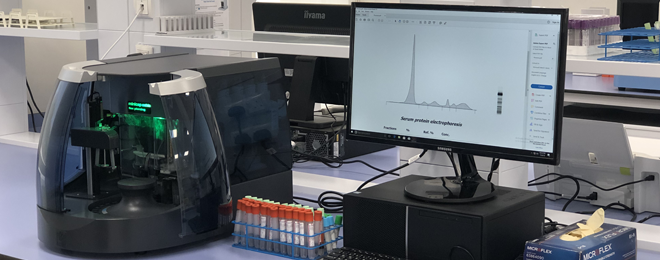
Blood and urine are composed of various protein moieties integral indicators in both health and disease conditions. Separating and quantifying these proteins from a serum and urine sample aid in diagnosis of infectious, allergic, nutritional and parasitic diseases in horses. Serum protein electrophoresis is also a valuable tool for the diagnosis of combined immunodeficiency in Arabian horses. Total Protein, Pre-Albumin, Albumin, globulins (Alpha globulin, Beta globulin, Gamma globulin) are assessed in automated capillary electrophoresis machines.
| Test | Sample | Handling | TAT |
|---|---|---|---|
| Serum Protein Electrophoresis |
Serum (Serum separator tube) |
Room temperature (Stable for 8 hours) 8hrs - Refrigerated with ice packs |
1 hr |
| Urine Protein Electrophoresis |
15 mL urine in sterile/non- sterile container |
Room temperature (Stable for 8 hours) 8hrs - Refrigerated with ice packs |
1 hr |
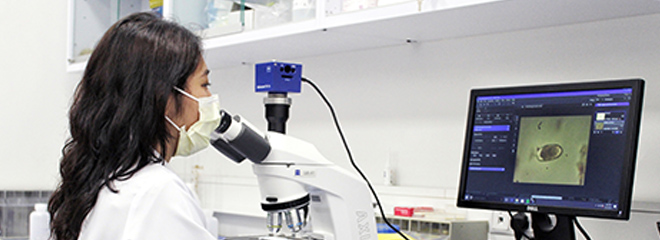
This section is simple yet vital in maintaining the well-being of horses by detecting external and internal parasites or parasitic ova in the fecal or skin scraping samples. Internal parasites being one of the common health concerns among horses wherein intestinal parasite like ascarids, large and small strongyles and tapeworms may cause weight loss, anemia, diarrhea and colic. Direct mount microscopy, fecal flotation, fecal sedimentation for lung worms, fecal sand test, Knott's test for equine microfilaria, fecal worm egg reduction test, Baermann's test for nematode larvae and quantitation of egg parasites in the stool using McMaster fecal egg count are the routine tests at the laboratory. Peripheral blood smears for suspected equine piroplasmosis and cryptosporidiosis by are examined using staining and microscopy. Skin scraping KOH test for checking external parasites and dermatophytes is available. Fecal occult blood test and nematode larvae culture test are in line to be added to the laboratory portfolio.
| Test | Sample | Handling | TAT |
|---|---|---|---|
| Fecal Floatation | 10g of stool |
1hr - Room Temperature;
1hr - Refrigerated |
1 hr |
| Direct Saline Smear | 10g of stool |
1hr - Room Temperature;
1hr - Refrigerated |
1 hr |
| Fecal Egg Count | 10g of stool |
1hr - Room Temperature;
1hr - Refrigerated |
1 hr |
| Fecal Sedimentation | 30g of stool |
1hr - Room Temperature;
1hr - Refrigerated |
1 hr |
| Fecal Flotation & Sedimentation | 50g of stool |
1hr - Room Temperature;
1hr - Refrigerated |
2 hr |
| Blood Parasite | Peripheral Blood Smear | Fixed or air dry before transport | 1 hr |
| Fecal Sand Test | 8 fecal balls |
1hr - Room Temperature;
1hr - Refrigerated |
2 hr |
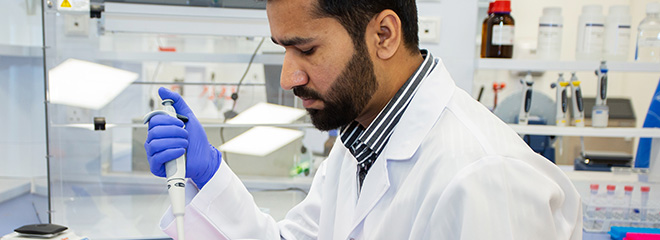
Our molecular diagnostic laboratory is equipped with the state-of-the-art equipment and facilities, including automated extraction and qPCR. Wide ranges of viral, bacterial, fungal, and parasitic infections are identified in our PCR laboratory by using qPCR, which is a powerful technique and used for rapid detection of pathogens, including those, which are difficult to culture. Advantages of Real-Time PCR include greater sensitivity, reproducibility, rapid analysis, better control of quality in the process, and a lower risk of contamination.
| Test | Sample | Handling | TAT |
|---|---|---|---|
| Equine herpes virus 1 |
Nasal/Nasopharyngeal Swab and EDTA or citrated blood |
Transport immediately to EVMC, in cool box with ice pack | 2-3 working days |
| Equine herpes virus 4 |
Nasal/Nasopharyngeal Swab and EDTA or citrated blood |
Transport immediately to EVMC, in cool box with ice pack | 2-3 working days |
| Equine Influenza H3N8 & H7N7 |
Nasal/Nasopharyngeal Swab | Transport immediately to EVMC, in cool box with ice pack | 2-3 working days |
| Rabies virus | Saliva, brain tissue | Transport immediately to EVMC, in cool box with ice pack | 2-3 working days |
| Rhodococcus equi | Tracheobronchial aspirate | Transport immediately to EVMC, in cool box with ice pack | 2-3 working days |
| Rotavirus | Fresh 5-10 g feces | Transport immediately to EVMC, in cool box with ice pack | 2-3 working days |
| Streptococcus equi | Nasopharyngeal wash/swab, Aspirate from abscess |
Transport immediately to EVMC, in cool box with ice pack | 2-3 working days |
| West Nile Virus | CSF | Transport immediately to EVMC, in cool box with ice pack | 2-3 working days |
| African Horse Sickness virus |
EDTA blood | Transport immediately to EVMC, in cool box with ice pack | 2-3 working days |
| Rotavirus & Corona Virus |
Fresh 5-10 g feces | Transport immediately to EVMC, in cool box with ice pack | 2-3 working days |
| Lawsonia intracellularis | Fresh 5-10 g feces | Transport immediately to EVMC, in cool box with ice pack | 2-3 working days |
| Clostridium difficile (Toxin A) |
Fresh 5-10 g feces | Transport immediately to EVMC, in cool box with ice pack | 2-3 working days |
| Clostridium difficile (Toxin B) |
Fresh 5-10 g feces | Transport immediately to EVMC, in cool box with ice pack | 2-3 working days |
| Babesia caballi | EDTA blood | Transport immediately to EVMC, in cool box with ice pack | 2-3 working days |
| Theileria equi | EDTA blood | Transport immediately to EVMC, in cool box with ice pack | 2-3 working days |
| Klebsiella pneumoniae | Sterile swabs nasopharyngeal, uterine, necropsy tissues. |
Transport immediately to EVMC, in cool box with ice pack | 2-3 working days |
| Klebsiella pneumoniae capsule type 1, 2, 5 |
Sterile swabs nasopharyngeal, uterine, necropsy tissues. |
Transport immediately to EVMC, in cool box with ice pack | 2-3 working days Individual test |
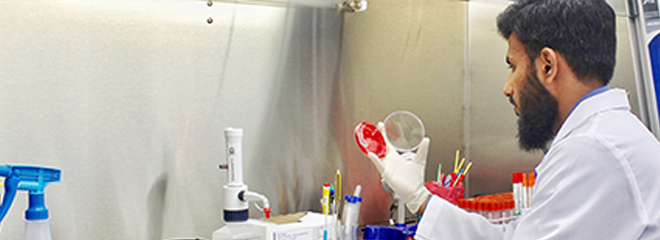
The microbiology laboratory performs phenotype profiling for wide range of bacteria and fungi of veterinary importance using standard microbiological techniques of culturing, incubating, isolation and identification with automated biochemical and proteomic approaches (Matrix Assisted Laser Desorption Ionization Time of Flight Mass Spectrometry). The laboratory is equipped with automated microbial detection system with quick and efficient microbial detection in blood or other body fluids (CSF, plural, pericardial and joint fluids) using aerobic and anaerobic culture media bottles.
Isolation, ID and AST of oxygen sensitive anaerobic bacteria are performed in atmosphere controlled anaerobic chamber. Different enrichment culture procedures are available for the identification of organisms. Both automated minimum inhibitory concentration (MIC) and manual disc diffusion method based on zone of bacterial inhibition around the antibiotic disc, are available for antimicrobial susceptibility under CLSI and EUCAST guidelines. The laboratory receives a wide range of clinical and environmental samples for bacterial and fungal isolation, identification and antimicrobial susceptibility testing (AST) on a daily basis. Various test plans are available for diagnosis and research.
| Test | Sample | Handling | TAT |
|---|---|---|---|
| Bacterial culture - aerobic (1 - 2 bacterial IDs & no AST) |
Affected tissue, body fluids or swabs in transport medium. | Refrigerate in insulated container with ice pakcs | 2-3 working days |
| Bacterial culture - anaerobic (1 - 2 bacterial IDs & no AST) |
Affected tissue, body fluids or swabs in transport medium. | DO NOT refrigerate. Send at room temperature in insulated container. | 2-3 working days |
| Antimicrobial susceptibility test (AST) | Affected tissue, body fluids or swabs in transport medium. Or pure bacterial culture. | Refrigerate in insulated container with ice pakcs. | 1-2 working days |
| Blood culture - aerobic (1 - 2 bacterial IDs & no AST) |
Whole blood in aerobic blood culture bottles. | DO NOT refrigerate. Send at room temperature | 2-4 working days |
| Blood culture - anaerobic (1 - 2 bacterial IDs & no AST) |
Whole blood in anaerobic blood culture bottles. | DO NOT refrigerate. Send at room temperature | 2-4 working days |
| Body fluid culture - aerobic (1 - 2 bacterial IDs & no AST) |
Body fluid in aerobic culture bottles | DO NOT refrigerate. Send at room temperature | 2-4 days |
| Body fluid culture - anaerobic (1 - 2 bacterial IDs & no AST) |
Body fluid in anaerobic culture bottles | DO NOT refrigerate. Send at room temperature | 2-5 days |
| Bacterial ID | Pure isolated bacterial culture | Refrigerate in insulated container with ice packs. | 1-3 days |
| Salmonella culture | Fresh feces, intestinal contents, other tissues, water or swabs. |
Refrigerate in insulated container with ice packs. | 2-4 working days |
| Clostridium culture | Fresh feces, intestinal contents or swabs in anaerobic transport medium. |
Refrigerate in insulated container with ice packs. | 2-4 working days |
| Streptococcus equi culture | Nasopharyngeal aspirate, tracheal wash, wound/abscess, endometrial or other tissues and swabs. |
Refrigerate in insulated container with ice packs. | 1-3 working days |
| Fungal KOH fluorescent stain | Skin scrapings, hair from lesion, affected tissue or body fluid, prepared slides | scrapings, hair & slides at room temperature, body fluids or tissues refrigerated | 1 working day |
| Fungal culture (Includes fungal ID & no susceptibility test) |
Skin scrapings, hair from lesion, affected tissue or body fluid etc. | scrapings, hair & slides at room temperature, body fluids or tissues refrigerated | 3-7 working days |
| Fungal susceptibility test | Skin scrapings, hair from lesion, affected tissue or body fluid etc. | scrapings, hair & slides at room temperature, body fluids or tissues refrigerated | 3-7 working days |
| Fungal ID | Isolated pure fungal colonies. | Refrigerate in insulated container with ice packs. | 3-7 working days |
| Enteric bacteriology Panel 1 Salmonella + clostridium culture |
Fresh feces, intestinal contents, other tissues, water or swabs in aerobic and anaerobic transport medium. |
One set refrigerated Second set at room temperature |
3-7 working days |
| Enteric bacteriology Panel 2 Aerobic + Anaerobic + salmonella + clostridium |
Fresh feces, intestinal contents, other tissues, water or swabs in aerobic and anaerobic transport medium. |
One set refrigerated Second set at room temperature | 3-7 working days |
| Dermatology panel KOH + Aerobic culture + Fungal culture |
Skin scrapings, hair from lesion, affected tissue or body fluid etc. | Scrapings, hair & slides at room temperature, Body fluids or tissues refrigerated | 3-7 working days |
| Environmental sterility test | Environmental/equipment swabs, dragged bandages etc. | Refrigerate in insulated container with ice packs. | 1-3 working days |
| Necropsy bacterial culture panel | Tissue samples from necropsy with suspected lesions. | For aerobic culture - refrigerate For anaerobic - Room temperature |
3-7 working days |
| Water microbiology panel Total Viable count + Coliform count |
Water sample | Refrigerate in insulated container with ice packs. | 2-3 working days |
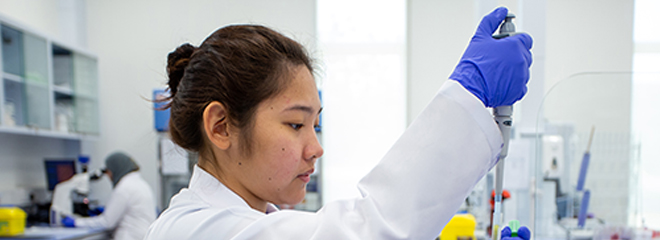
The endocrine glands: pituitary, thyroid, parathyroid, pancreas, ovaries and testes produce hormones necessary for balanced functions in metabolisms, general growth, reproduction, and the body’s response to combat stress. Our diagnostic tests for the endocrine system are building up. We use automated fluorescence enzyme immunoassay for adrenocorticotropic hormones, progesterone, testosterone, free thyroxine, insulin and cortisol. Adiponectin, Anti-Müllerian hormone, leptin, estradiol, and inhibin using equine specific enzyme-linked immunosorbent assay are in line to be added to the endocrinology lab.
| Test | Sample | Handling | TAT |
|---|---|---|---|
| ACTH | Plasma (EDTA/Lavender top) |
Refrigerated with ice packs |
1 hr |
| Progesterone | Serum (Serum separator tube) or Plasma (Lithium heparin) |
Refrigerated with ice packs | 1 hr |
| T4 | Plasma (Lithium heparin) or Serum (Plain Tube) |
Refrigerated with ice packs or Frozen |
1 hr |
| Cortisol | Preferrably Serum (Serum separator tube) or Plasma (Lithium heparin) | Refrigerated with ice packs or Frozen |
1 hr |
| Insulin | Serum (Serum separator tube) or Plasma (Lithium heparin) | Refrigerated with ice packs or Frozen |
1 hr |
| Testosterone | Serum (Plain tube) or Plasma (Lithium heparin) | Refrigerated with ice packs or Frozen |
1 hr |
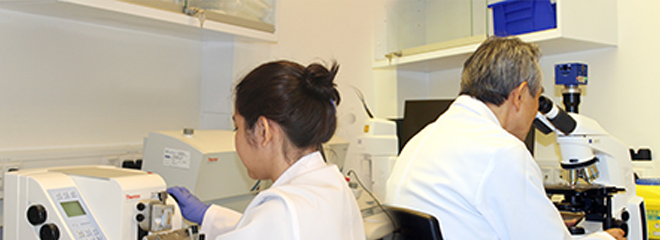
In histopathology, physical alterations to the cellular architecture in response to infectious, necrotic or neoplastic insult to the tissue samples are observed under the microscope. Currently, common histopathology services are available for examining endometrial biopsies, visceral organ tissues samples from post-mortem cases, and samples from the tumors. Apart from routine H&E stain,various other stains are also used on the processed fine sections of the tissues for examination. The histopathology laboratory is equipped with Immuno-histo chemistry and in situ hybridization staining equipment for diagnosis and research.
| Test | Sample | Handling | TAT |
|---|---|---|---|
| Endometrial Biopsy Full-upto 2 sites | Fresh sample or fixed in formalin | Keep refrigerated with ice pack if there is no formalin | 3 - 5 working days |
| Soft Tissue Biopsy Full-upto 2 sites | Fresh sample or fixed in formalin | Keep refrigerated with ice pack if there is no formalin | 3 - 5 working days |
| Melanoma Biopsy Full -upto 2 sites | Fresh sample or fixed in formalin | Keep refrigerated with ice pack if there is no formalin | 3 - 5 working days |
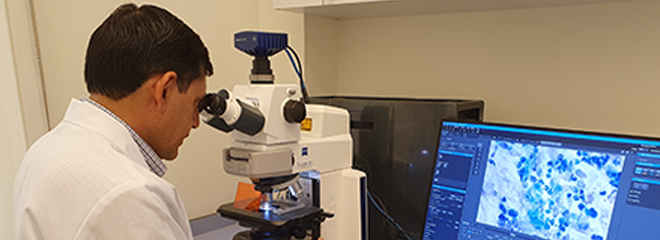
In comparison to histopathology techniques, diagnostic cytology provides a quick and relatively non-invasive way to evaluate the cellular reaction to infection, inflammation and neoplasms. Important factors affecting the cytological picture are the type of injury or the type of invading pathogen, the site of infection process, its route of entry and the stage of the disease i.e. acute and chronic recurrent phase. The types of cells such as epithelial cells, neutrophils, lymphocytes, monocytes, bacteria or fungi are evaluated. The role of specific cells such as in ensuing immune response, phagocytic activity of monocytes and their activated forms in removing cell debris and pathogenic organisms, the extent of tissue damage, the stage of disease and the prognosis are assessed. Currently, Diff Quick or Giemsa stain, Gram's stain, Papanicolaou and PAS stains are routinely used for diagnostic cytology.
| Test | Sample | Handling | TAT |
|---|---|---|---|
| General Body Fluid Panel | Body fluid in EDTA tube or Lavander top |
1hr - Room Temperature;
1hr - Refrigerated |
2 hr |
| Peritoneal Fluid Panel | Peritoneal fluid in EDTA tube and Plain tube |
1hr - Room Temperature;
1hr - Refrigerated |
2 hr |
| Joint Fluid Panel | Joint fluid in EDTA tube |
1hr - Room Temperature;
1hr - Refrigerated |
2 hr |
| Blood Cytology Smear | Smear or whole blood in EDTA Tube |
1hr - Room Temperature;
1hr - Refrigerated Fixed or air dry smear before transporting. |
1 hr |
| Joint Fluid Cytology Slide | Joint fluid in EDTA tube |
1hr - Room Temperature;
1hr - Refrigerated |
1 hr |
| Peritoneal Fluid Cytology | Joint fluid in EDTA tube |
1hr - Room Temperature;
1hr - Refrigerated |
1 hr |
| TTW Cytology | Smear or Sample in EDTA Tube |
1hr - Room Temperature;
1hr - Refrigerated Fixed or air dry smear before transporting. |
1 hr |
| CSF Cytology | Plain Tube or EDTA Tube |
Plain Tube for STAT
EDTA tube if transport takes 20 mins |
1 hr |
| Bone Marrow Cytology | Plain Tube or EDTA Tube |
Plain Tube for STAT
EDTA tube if transport takes 20 mins |
1 hr |
| Endometrial Cytology | Smear | Fixed or air dry smear before transporting. |
1 hr |
| FNA Cytology | Syringe, EDTA tube, or smear |
1hr - Room Temperature;
1hr - Refrigerated Fixed or air dry smear before transporting. |
1 hr |
| Impression Smear Cytology | Smear | Fixed or air dry before transporting. | 1 hr |
| Urine Cytology | 15 mL urine |
1hr - Room Temperature;
1hr - Refrigerated Fixed or air dry smear before transporting. |
1 hr |
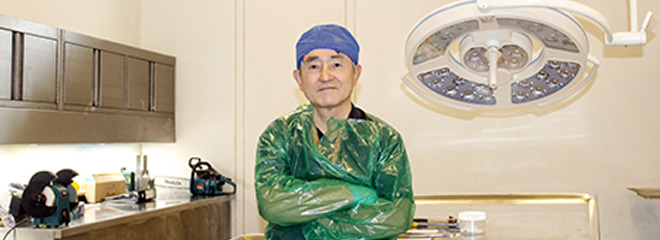
A well-established necropsy service is available at EVMC carried out by well renowned pathologist with years of experience. Apart from regular necropsy for neonatal and adult horses, we also examine aborted fetuses and placentas to understand the plausible cause of death. Strict biosecurity measures are in place and efficient carcass disposal by a third party contractor is available. Presenting approved Necropsy Request Form is mandatory for carrying out the necropsy examination.
| Test | Sample | Handling | TAT |
|---|---|---|---|
| Necropsy | Fetus/Placenta | Refrigerated | 2 working days |
| Necropsy | Neonatal/Foal | Refrigerated | 5-7 working days |
| Necropsy | Adult horse | Refrigerated | 5-7 working days |
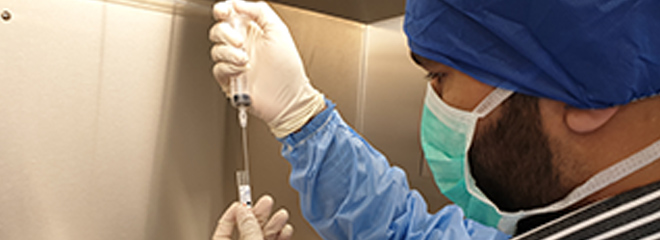
At the moment the laboratory offers platelet rich plasma (PRP) and Interleukin-1 Receptor Antagonist Protein (IRAP) are concentrated from the blood samples of in-house horse patients at EVMC. These therapies are getting popular for the treatment of musculoskeletal injuries and osteoarthritis in horses. Platelets are blood cells smaller than RBC; they play an important role in hemostasis and are considered to be the natural sources of growth factors. The growth factors are believed to be actively involved in wound healing and other regenerative processes in the wake of injuries. These growth factors are rich in concentrated platelet preparations. After preparation, these products are injected back into the same horses sampled to promote tissues repair in joint and soft tissue injuries. At the site of trauma and joint swelling inflammatory proteins such as cytokines and Interleukin-1 (IL-1) are released, IRAP therapy prevents IL-1 binding to the joint tissues minimizing the damaging effect of IL-1 in the affected joint. Other products such as stem cell therapy are in line to be added to EVMC laboratory. Regenerative medicine laboratory is following strict good manufacturing practices (GMP).
| Test | Sample | Handling | TAT |
|---|---|---|---|
| Platelet Rich Plasma | ACD-A blood | Room Temperature | Same day |
| iRAP processing | Orthokine vet iRAP 60 syringe | Room Temperature | 2 working days |